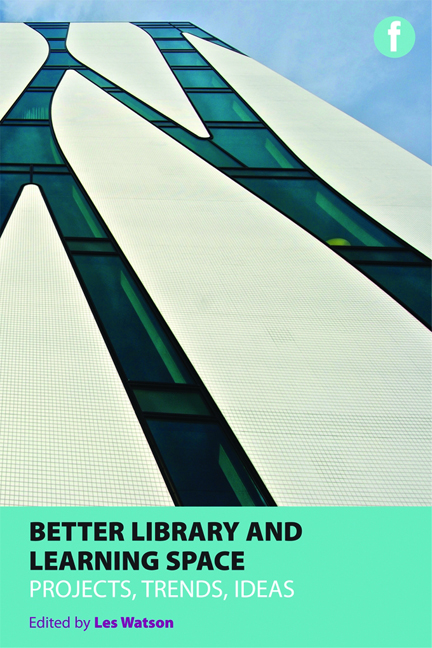Book contents
- Frontmatter
- Contents
- Case studies
- Acknowledgements
- Contributors
- Introduction – about this book
- PART 1 PROJECTS AND TRENDS
- PART 2 TRENDS AND IDEAS
- PART 3 IDEAS AND FUTURES
- Introduction
- 11 Beyond space: access is all – or is it?
- 12 Thinking inside the box
- 13 Nothing has changed/everything has changed – the enduring aspects of learning
- 14 Books, nooks and MOOCs
- 15 The researcher's view: context is critical
- 16 Libraries in the network society: evolution, revolution, extinction?
- 17 Powered by learning: developing models of provision to meet the expectations of new generations of students
- 18 The library has left the building
- 19 Beyond analogue: the learning studio as media-age library
- 20 3D libraries for 3D smarting
- 21 Learning landscapes, the library and the University of Lincoln: efficiency, effectiveness, expression and experimentation
- 22 Viral design: learners building better environments together
- 23 The interior designer's view
- 24 Furniture fit for the future – a brief exploration of library and learning furniture today and for the coming generation
- 25 Conclusions
- Index
23 - The interior designer's view
from PART 3 - IDEAS AND FUTURES
Published online by Cambridge University Press: 08 June 2018
- Frontmatter
- Contents
- Case studies
- Acknowledgements
- Contributors
- Introduction – about this book
- PART 1 PROJECTS AND TRENDS
- PART 2 TRENDS AND IDEAS
- PART 3 IDEAS AND FUTURES
- Introduction
- 11 Beyond space: access is all – or is it?
- 12 Thinking inside the box
- 13 Nothing has changed/everything has changed – the enduring aspects of learning
- 14 Books, nooks and MOOCs
- 15 The researcher's view: context is critical
- 16 Libraries in the network society: evolution, revolution, extinction?
- 17 Powered by learning: developing models of provision to meet the expectations of new generations of students
- 18 The library has left the building
- 19 Beyond analogue: the learning studio as media-age library
- 20 3D libraries for 3D smarting
- 21 Learning landscapes, the library and the University of Lincoln: efficiency, effectiveness, expression and experimentation
- 22 Viral design: learners building better environments together
- 23 The interior designer's view
- 24 Furniture fit for the future – a brief exploration of library and learning furniture today and for the coming generation
- 25 Conclusions
- Index
Summary
Introduction
In Interior Design of the 20th Century, Anne Massey (1990) states that ‘Interior design is a phenomenon born of the 20th century, to be precise the latter half of the 20th century’.
The profession of interior design is a young, evolving discipline that was first formalized in the UK as recently as the late 1960s when a number of tertiary level education courses were inaugurated. One of the most recent environments to employ interior design is the education sector and in particular libraries and learning commons. In the last ten years there has been a surge of interest in the design of ‘learning environments’, which has stimulated widespread refurbishment and building programmes in higher and further education institutions. This interest has been influenced by a complex number of cultural, pedagogic and technological developments and influences. In addition, widening access to higher education has led to greater diversity in student populations.
Oblinger (2003) provides a useful overview of the new student:
The ‘new’ student may be a seventeen-year-old high school student (a ‘Millennial’) who uses instant messaging to contact peers and teachers. The ‘new’ students may be a twenty-six-year old college student (a ‘Gen-X’ whose expectations of customer service are radically different from those of previous generations. Or the ‘new’ student may be a forty-year-old working mother (a ‘Baby-Boomer’) who is completing a degree via e learning so that she can balance work and family responsibility.
The most significant factor driving these changes is the explosion of new technology, particularly social media that enables students to participate in and debate information while sharing this with friends and colleagues often entirely online. Despite this many educators believe that there is a greater need than ever for new spaces to provide opportunities for face-to-face interaction and collaboration. The introduction of technologies to support learners has significantly changed the way that libraries, in particular, look. Evolution from banks of desktop computers to hand held or mobile devices has driven demand for new types of furniture, lighting and accessible power and data outlets. Presentation equipment supporting face-to-face collaboration has further changed the landscape of spaces, emphasizing flexible semi-private spaces with many libraries using pods or booths to facilitate this activity.
- Type
- Chapter
- Information
- Better Library and Learning SpaceProjects, trends and ideas, pp. 249 - 258Publisher: FacetPrint publication year: 2013



